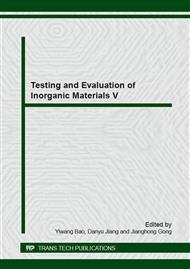p.265
p.269
p.273
p.277
p.281
p.286
p.290
p.295
p.299
Ice-Formation Expansion of Salt Solution and its Effect on Frost Damage of Concrete
Abstract:
In order to explain the deterioration mechanism of air entrained concrete subjected to freeze-thaw cycles in water, NaCl, Na2SO4 and composite solution, The damage of concrete and ice-formation expansion of salt corrosion solution are tested. The experimental results show that the damage degree of concrete under salt frost is NaCl solution>composite solution>water>Na2SO4 solution. Considering the chloride penetrated into concrete and following 2nd Fick’s Law, the ice-formation expansion resulted by NaCl solution in surface layer of concrete is higher than that in inner, and the expansion stress at outer layer is 1.73 times of that at inner layer according to the proposed function. The expansion stress difference between the internal and external layer causes spalling damage of concrete in chloride salt frost. The ice-formation expansion of Na2SO4 solution increases with its raising concentration and it is higher than that of NaCl solution at the same temperature. However, the corrosion products are ettringite and gypsum after sulfate salt frost, and the volume of solid corrosion products is barely change, or even reducible.
Info:
Periodical:
Pages:
281-285
Citation:
Online since:
November 2014
Authors:
Keywords:
Price:
Сopyright:
© 2015 Trans Tech Publications Ltd. All Rights Reserved
Share:
Citation:


